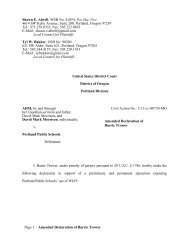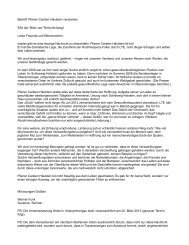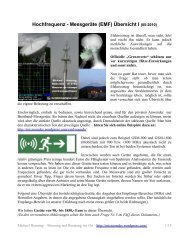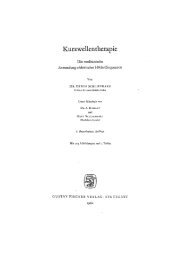3 Articles (English/German) about the study - Micro-ondes
3 Articles (English/German) about the study - Micro-ondes
3 Articles (English/German) about the study - Micro-ondes
You also want an ePaper? Increase the reach of your titles
YUMPU automatically turns print PDFs into web optimized ePapers that Google loves.
doi:10.1136/jech.2010.115402<br />
• Research report<br />
Cell phone use and behavioural problems in young children<br />
1. Hozefa A Divan1<br />
,<br />
2. Leeka Kheifets2<br />
, 3. Carsten Obel3<br />
, 4. Jørn Olsen2<br />
,3<br />
+ Author Affiliations<br />
1. 1 Division of Biostatistics, Department of Preventive Medicine, Keck School of Medicine of <strong>the</strong><br />
University of Sou<strong>the</strong>rn California, Los Angeles, California, USA<br />
2. 2 Department of Epidemiology, School of Public Health, University of California, Los Angeles,<br />
California, USA<br />
3. 3 Institute of Public Health, University of Aarhus, Aarhus, Denmark<br />
1. Correspondence to Dr Leeka Kheifets, UCLA Pub Hlth-Epid, Box 951772, 73-320 CHS, Los<br />
Angeles, CA 90095-1772, USA; kheifets@ucla.edu<br />
• Accepted 22 September 2010<br />
• Published Online First 7 December 2010<br />
Abstract<br />
Background Potential health effects of cell phone use in children have not been adequately examined.<br />
As children are using cell phones at earlier ages, research among this group has been identified as <strong>the</strong><br />
highest priority by both national and international organisations. The authors previously reported<br />
results from <strong>the</strong> Danish National Birth Cohort (DNBC), which looked at prenatal and postnatal<br />
exposure to cell phone use and behavioural problems at age 7 years. Exposure to cell phones prenatally,<br />
and to a lesser degree postnatally, was associated with more behavioural difficulties. The original<br />
analysis included nearly 13 000 children who reached age 7 years by November 2006.<br />
Methods To see if a larger, separate group of DNBC children would produce similar results after<br />
considering additional confounders, children of mo<strong>the</strong>rs who might better represent current users of<br />
cell phones were analysed. This ‘new’ dataset consisted of 28 745 children with completed Age-7<br />
Questionnaires to December 2008.<br />
Results The highest OR for behavioural problems were for children who had both prenatal and<br />
postnatal exposure to cell phones compared with children not exposed during ei<strong>the</strong>r time period. The<br />
adjusted effect estimate was 1.5 (95% CI 1.4 to 1.7).<br />
Conclusions The findings of <strong>the</strong> previous publication were replicated in this separate group of<br />
participants demonstrating that cell phone use was associated with behavioural problems at age 7 years<br />
in children, and this association was not limited to early users of <strong>the</strong> technology. Although weaker in<br />
<strong>the</strong> new dataset, even with fur<strong>the</strong>r control for an extended set of potential confounders, <strong>the</strong> associations<br />
remained.<br />
Source: http://jech.bmj.com/content/early/2010/11/11/jech.2010.115402.abstract








